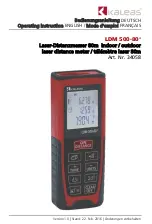
Operating Instructions 45
one (or zero) results in the standard demand measurement without rolling demand. See
for information on configuring the demand.
Any changes to the demand configuration (
) or CT configuration
(
,
,
) will zero the reported demand and
start a new demand measurement. The
DemandMin
and
DemandMax
will not be reset by
configuration changes.
To manually zero some or all of the demand registers, see the
below.
The floating point demand registers are reported in units of watts, while the integer demand
registers must be scaled by
PowerIntScale
to compute watts. To scale the integer
Demand
,
DemandA
,
DemandB
,
DemandC
,
DemandMin
,
DemandMax
, or
DemandApp
, use the follow-
ing equation:
Demand(W) = Demand • PowerIntScale
For example, if
PowerIntScale
(
1609
) is 100, and the integer
Demand
(
1354
) reports 4700, then
the demand is 4700 * 100 = 470,000 watts (or 470 kW).
Demand
Subinterval
Demand
Subinterval
Demand
Subinterval
Demand
Subinterval
Demand
Subinterval
Demand
Subinterval
Demand
Subinterval
Demand
Interval
Demand
Interval
Demand
Interval
Demand
Interval
Demand
Interval
Po
w
er
(w
at
ts)
Demand
Power
Curve
Figure 11: Rolling Demand with Three Subintervals
Demand
The
Demand
register is updated at the end of every subinterval with the average
PowerSum
over a full demand interval. After a power cycle or configuration change,
Demand
will report zero
until the completion of one full demand interval.
DemandA, DemandB, DemandC
The real power demand is computed for each phase from
PowerA
,
PowerB
, and
PowerC
.
DemandMin
The
DemandMin
is the smallest measured
Demand
(this may be negative for systems with
power generation). It is preserved across power failures and can be reset with the
















































